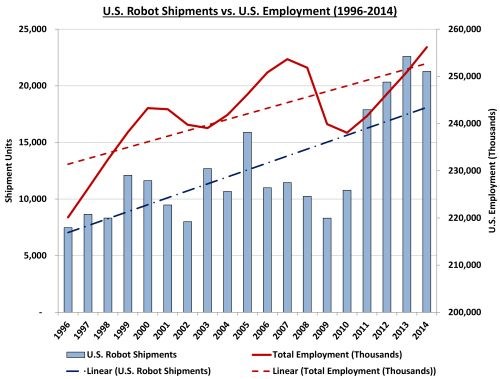Positive Correlation between Robots and Employment
Do robots replace employees? Far from it. Data suggest employment and automation grow together, while individual cases show automation raising employee value and helping the employer attract talent.

What is the relationship between robotic automation and employment? The relationship would seem to be an inverse one. That is, as the use of robots increases, employment should go down—or so we might expect.
A new white paper from the Association for Advancing Automation (A3) demonstrates that this expectation is false. Robots do not appear to replace employees, because the correlation between them is positive. When robot shipments have gone up, employment has gone up at the same time.
U.S. employment data compared to U.S. robot shipments show this. During periods when robot sales were increasing, employment has been generally increasing as well. The correlation was particularly apparent from 2010 to 2013, when both U.S. employment and U.S. robots sales grew steadily. (Employment then dropped a notch in 2014, while robot sales continued to grow.)
The paper also gives examples of companies that have increased both employment and the use of robots. Marlin Steel is one these. The company’s CEO, Drew Greenblatt, is quoted. “Not only has changing over to an automated production process saved our company from the threat of bankruptcy, saving the jobs of everyone here, it has allowed us to expand our work force,” he says. “Since going automated, Marlin Steel has nearly doubled the size of the work force, adding engineers and automated production specialists to our existing team.”
Those job types he mentions suggest another aspect of automation’s impact on employment that the A3 paper also addresses. Namely: The jobs added are often higher in responsibility and compensation than what was typical of the company’s workforce before it increased automation.
Robots, in fact, are helping with the need to attract talent to manufacturing. Vickers Engineering CEO Matt Tyler sees this. After his company’s shift to automation, he says, “We’re now able to attract people who aren’t just looking to draw a paycheck, they’re looking for a career.” Vickers senior automation engineer Jordan Klint adds, “In order to bring young people into the business, you have to have technology. The guys who report to me really enjoy the robotics side. They think robots are cool.”
Obtain the white paper at A3automate.org, and read further thoughts about the relationship between robots and employment here and here.
Related Content
-
Inside the Premium Machine Shop Making Fasteners
AMPG can’t help but take risks — its management doesn’t know how to run machines. But these risks have enabled it to become a runaway success in its market.
-
Which Approach to Automation Fits Your CNC Machine Tool?
Choosing the right automation to pair with a CNC machine tool cell means weighing various factors, as this fabrication business has learned well.
-
Modern Bar Feeds Bring New Life to Automatic Swiss Lathes
Cam-actuated Swiss lathes are still the fastest way to process many parts. By adding modern bar feeders, this shop has dramatically improved their utilization with the ability to work unattended, even in a lights-out environment.

.jpg;width=70;height=70;mode=crop)






.png;maxWidth=300;quality=90)







